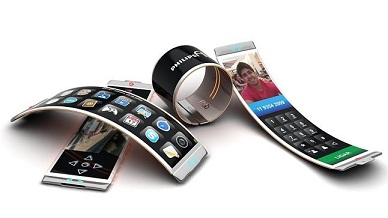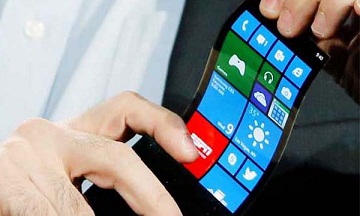Smartphone's emerges by way of a new design with flexible display:
A flexible display is a display which is flexible in its nature, differentiable from more prevalent traditional flat screen displays utilized in most electronics devices. In recent years there has been a growing interest from various consumer electronics manufacturers to apply this display technology in e-readers, mobile phones and other consumer electronics.

What do you mean by a Flexible OLED Display?
Flexible OLED is an emerging technology which is already being used in a number of mobile phones as well as TV-sets. When talking about flexibility, it is important to mind that there are different kinds of this technology and not all devices with flexible OLEDs will be bendable indeed.
Such OLEDs are based on flexible substance which can be made either from plastic or metal or even flexible glass. In arrears to such materials, flexible OLEDs are light and thin. It is presume by Analysts that it will be rather durable and even shatter-proof.
Wraparound tech:
In the future, the mobile phone will be our flexible friend which is capable of rolling up or curling at the edges to alert us to a message. This future gazing prototype known as More-Phone is from developers at the Canadian-based Human Media Lab. It is based on flexible plastic display technology developed in the UK at the Cambridge R&D wing of Plastic Logic.
At Plastic Logic's HQ, Rachel Lichten expresses how the R&D team at Plastic Logic has developed a process for developed paper-thin flexible Electrophoretic Plastic displays which mimic the appearance of conventional ink on paper. Polymers are used to create layers of electronic transistors also benefit of polymers is that they can be processed.
Screens you can stomp on:
The flexible OLED screens can be scaled to any size and do not require backlighting to be clearly legible in direct sunlight. It can be in black, white or colours also are very thin and lightweight - Lichten says you can even stomp on them. Their consumption of power is very low therefore no needed for large cumbersome batteries, making them ideal for wearable applications.
Flexible display pros & cons:
Same as any other technology flexible OLEDs screen have some positive as well as negative sides. But for being rather innovative flexible displays comprises such advantages as:
1) Unbreakable:
Unlike glass screen flexible OLED displays are more durable and will be virtually unbreakable. Due to such type of technology manufacturers will be able to create thinner and lighter pocket-friendly devices. Rather than a common screen these displays are less prone to scratching as well as cracking. Flexible screen emit less heat also are more energy efficient.
2) Design:
Due to bendable displays technology there is no need for borders or bezels. The display can be edge to edge that can show some specific data on the edge provide touch sensitive controls and what not. Flexible OLEDs allow changing factor of devices as well as bringing a number of new shapes.
3) Dimensions:
Flexible displays are much thinner and lighter than glass screens we have got used to. OLED screen will be large enough.
4) Doubtful flexibility:

First flexible OLED Smartphone's would not be able to bend. Most likely developers will stick flexible displays to non flat surface of future devices. Therefore, the final user would not be able to bend them. Conversely, such phones will have a number of prerogatives:-
They will be much thinner and lighter than the present Smartphone's
Unlike glass screens which can hardly pass-drop tests these days, Smartphone's with flexible OLEDs will be more durable.
Report goes that the 2G (second generation) of Smartphone's with flexible screen will be truly bendable. This means that the final user will get a device which can be folded, stretched as well as bended.
Internal hardware and battery issues:
One of the 1st questions that would arise while talking about bendable Smartphone's is what kind of battery it should be powered by. As of now, it is not heard about the flexible batteries development which could be put inside flexible Smartphone's where wearable technique come to mind. Just visualize that flexible device could be powered wirelessly with batteries incorporated into clothes. It sounds really like a miracle. Perhaps manufacturers will come up with some other sources of power for new bendable Smartphone's.
This is always the way with new technologies, ‘bringing it to market on the one hand is a challenge, especially because it is revolutionary. However for the next generation of products, you have to know what the next generation of products will be.' Working with mobile phones or laptops that roll-up, could turn hardware into ‘flexi-ware'.